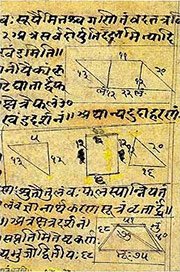Dashamsha, Daśāṃśa, Dashan-amsha: 6 definitions
Introduction:
Dashamsha means something in Hinduism, Sanskrit. If you want to know the exact meaning, history, etymology or English translation of this term then check out the descriptions on this page. Add your comment or reference to a book if you want to contribute to this summary article.
The Sanskrit term Daśāṃśa can be transliterated into English as Dasamsa or Dashamsha, using the IAST transliteration scheme (?).
In Hinduism
Ganitashastra (Mathematics and Algebra)
Source: archive.org: Hindu MathematicsDaśāṃśa (दशांश) or Daśabhāga refers to “ten-parts” (i.e., one-tenth) in Bhinna (“fractions”) and Bhāga (“unit fractions”), which refers to one of the twenty operations (logistics) of pāṭīgaṇita (“science of calculation which requires the use of writing material—the board”), according to Pṛthudakasvāmī’s commentary on the Brāhmasphuṭasiddhānta by Brahmagupta, a Sanskrit treatise on ancient Indian mathematics (gaṇita-śāstra) and astronomy from the 7th century.—In the Śulba, unit fractions are denoted by the use of a cardinal number with the term bhāga or aṃśa; thus pañcadaśa-bhāga (“fifteen-parts”) is equivalent to one-fifteenth, sapta-bhāga (“seven-parts”) is equivalent to one-seventh, and so on [e.g., daśāṃśa].

Ganitashastra (शिल्पशास्त्र, gaṇitaśāstra) refers to the ancient Indian science of mathematics, algebra, number theory, arithmetic, etc. Closely allied with astronomy, both were commonly taught and studied in universities, even since the 1st millennium BCE. Ganita-shastra also includes ritualistic math-books such as the Shulba-sutras.
Languages of India and abroad
Sanskrit dictionary
Source: DDSA: The practical Sanskrit-English dictionaryDaśāṃśa (दशांश).—bad days, straitened condition; परिमृष्टो दशान्तेन दशभागेन सेव्यते (parimṛṣṭo daśāntena daśabhāgena sevyate) Rām.3.72.8.
Derivable forms: daśāṃśaḥ (दशांशः).
Daśāṃśa is a Sanskrit compound consisting of the terms daśā and aṃśa (अंश). See also (synonyms): daśābhāga.
Source: Cologne Digital Sanskrit Dictionaries: Monier-Williams Sanskrit-English DictionaryDaśāṃśa (दशांश):—[from daśa] m. a 10th part, [Śāktānanda-taraṅgiṇī xii; Hemādri’s Caturvarga-cintāmaṇi i, 10 f.]
[Sanskrit to German]
Sanskrit, also spelled संस्कृतम् (saṃskṛtam), is an ancient language of India commonly seen as the grandmother of the Indo-European language family (even English!). Closely allied with Prakrit and Pali, Sanskrit is more exhaustive in both grammar and terms and has the most extensive collection of literature in the world, greatly surpassing its sister-languages Greek and Latin.
Kannada-English dictionary
Source: Alar: Kannada-English corpusDaśāṃśa (ದಶಾಂಶ):—
1) [noun] any of the ten equal parts of something.
2) [noun] (arith.) a fraction with an unwritten denominator of 10 or some power of 10, indicated by a point (decimal point) before the numerator; a decimal.
Kannada is a Dravidian language (as opposed to the Indo-European language family) mainly spoken in the southwestern region of India.
See also (Relevant definitions)
Partial matches: Dasa, Amsha, Tacan, Taca.
Starts with: Dashamshaapurnanka, Dashamshacinha, Dashamshacinnham.
Ends with: Ashtadashamsha, Avartadashamsha, Caturdashamsha, Dvadashamsha, Ekadashamsha, Navadashamsha, Pancadashamsha, Saptadashamsha, Shodashamsha, Trayodashamsha.
Full-text: Tacamicam, Dashabhaga, Dvadashamsha, Abhisheka.
Relevant text
Search found 2 books and stories containing Dashamsha, Daśāṃśa, Dasamsa, Daśā-aṃśa, Dashan-amsha, Dasa-amsa, Daśamśa, Dasha-amsha, Daśa-aṃśa, Daśan-aṃśa, Dasan-amsa; (plurals include: Dashamshas, Daśāṃśas, Dasamsas, aṃśas, amshas, amsas, Daśamśas). You can also click to the full overview containing English textual excerpts. Below are direct links for the most relevant articles:
Significance of the Moon in Ancient Civilizations (by Radhakrishnan. P)
8. Poetess Smt. Nalapat Balamani Amma < [Chapter 14 - Case Studies of Natal Chart]
2. Dr. Balamuralikrishna (Carnatic Voclist) < [Chapter 14 - Case Studies of Natal Chart]
Kashyapa Shilpa-shastra (study) (by K. Vidyuta)
4. Fourteen types of Samāśra (Square) Maṇḍapas < [Chapter 4 - Maṇḍapa Lakṣaṇa]